APNet'23 Talk Transcription for FastWake: Revisiting Host Network Stack for Interrupt-mode RDMA
Although most people prefer watching videos, I prefer reading text because text facilitates non-linear searching, allows for quick skimming, and is convenient for reviewing previous content at any time.
Recently, I have converted some of my lecture videos at academic conferences into text, such as ClickNP, KV-Direct and The New Golden Age of Computer Networks Series. Today, I am releasing FastWake from APNet 2023. Before the ClickNP and KV-Direct presentations, I would write the script in the notes of the PPT and read it directly on the spot. This year, even the PPT was rushed to finish the day before the conference, and there was no time to write notes, let alone a complete practice. I just went on stage to speak.
Now with large models, it’s not difficult to convert lecture videos into PPT + text scripts. In fact, I’ve always wanted to make such an online conference plugin.
- Extract the key frames from the video to form a PPT image list. If the difference between each frame and the previous one exceeds a certain threshold, it is considered that a PPT page has been switched. An open-source software video2pdf can do this.
- OCR each image into text, all are printed characters, the recognition accuracy is very high, Tesseract can do it.
- Extract the video soundtrack that stays on each PPT page and give it to the Speech-to-Text model for recognition, for example, I use OpenAI’s open source Whisper.
- (The last step is very important) Let the large language model (such as GPT-4) refer to the current page PPT and the homepage PPT content OCR’d out, and correct the transcription recognized by the Speech-to-Text model.
The current Speech-to-Text model is not very accurate in recognizing proper nouns and names, but many of these proper nouns have appeared on this page of PPT, and the PPT homepage also frames the title and field of the speech. Therefore, with the PPT content as a reference, the large language model can correct most of the errors in recognizing proper nouns. Without the PPT content as a reference, GPT-4 is needed to correct most of the proper nouns, but with the PPT content, LLaMA-2-70b-chat is enough. In addition, the large language model can correct the colloquial expressions in the speech, making the text script more rigorous and readable.
The following text script is completely auto-generated, except for a few names, nothing has been changed. Of course, some minor errors are also retained, but they are all harmless. The Video2PDF, Tesseract, Whisper, and LLaMA-2-70b-chat models used in the whole process all run on my own Mac notebook, and no internet connection is required throughout the process.
Video Content
Bojie Li, Zihao Xiang, Xiaoliang Wang, Han Ruan, Jingbin Zhou, and Kun Tan. FastWake: Revisiting Host Network Stack for Interrupt-mode RDMA. In 7th Asia-Pacific Workshop on Networking (APNET 2023), June 29–30, 2023, Hong Kong, China.
Text Script
(Session Chair Gaoxiong Zeng) Okay, let’s start. Welcome to the APNet 2023 session number one on host networking. I am Gaoxiong Zeng from Huawei Technologies. In this session, we have four very interesting papers focusing on host networking and RDMA. Each paper will be presented with a 17-minute talk followed by 3 minutes for Q&A. I hope you enjoy it.
Let’s start with the first paper titled “FastWake: Revisiting Host Network Stack for Interrupt-mode RDMA”. The speaker is Dr. Bojie Li. Dr. Bojie Li is a technical expert at Huawei Technologies. His research interests include high-performance data center systems. Currently, he is focusing on high-performance data center interconnect and RPC. He received his Ph.D. degree in 2019 and won the ACM China Doctoral Dissertation Award. Let’s welcome him.
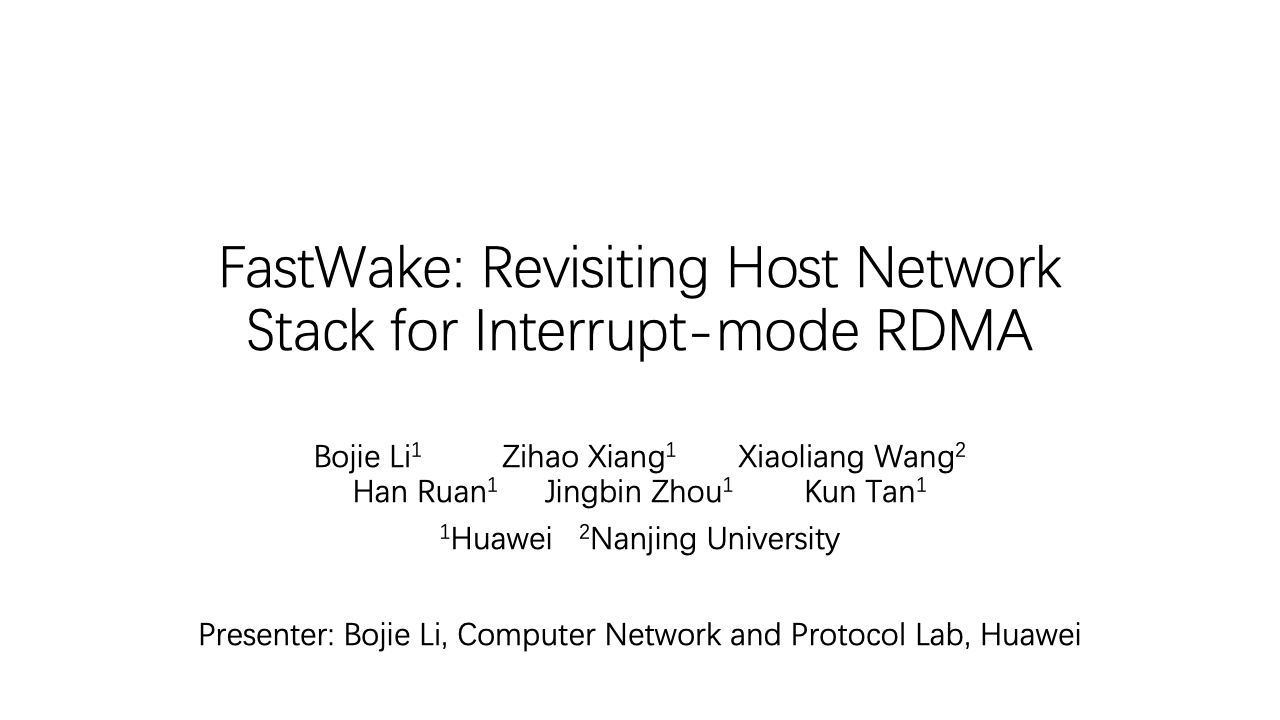
(Presenter Bojie Li) Thank you, Gaoxiong, for the introduction. I’m honored to be the first speaker following Prof. Haibo Chen’s keynote. I will present “FastWake: Revisiting Host Network Stack for Interrupt-mode RDMA”. I currently work with the Computer Network Protocol Lab at Huawei, and this is a joint work with our lab and Prof. Xiaoliang Wang from Nanjing University.
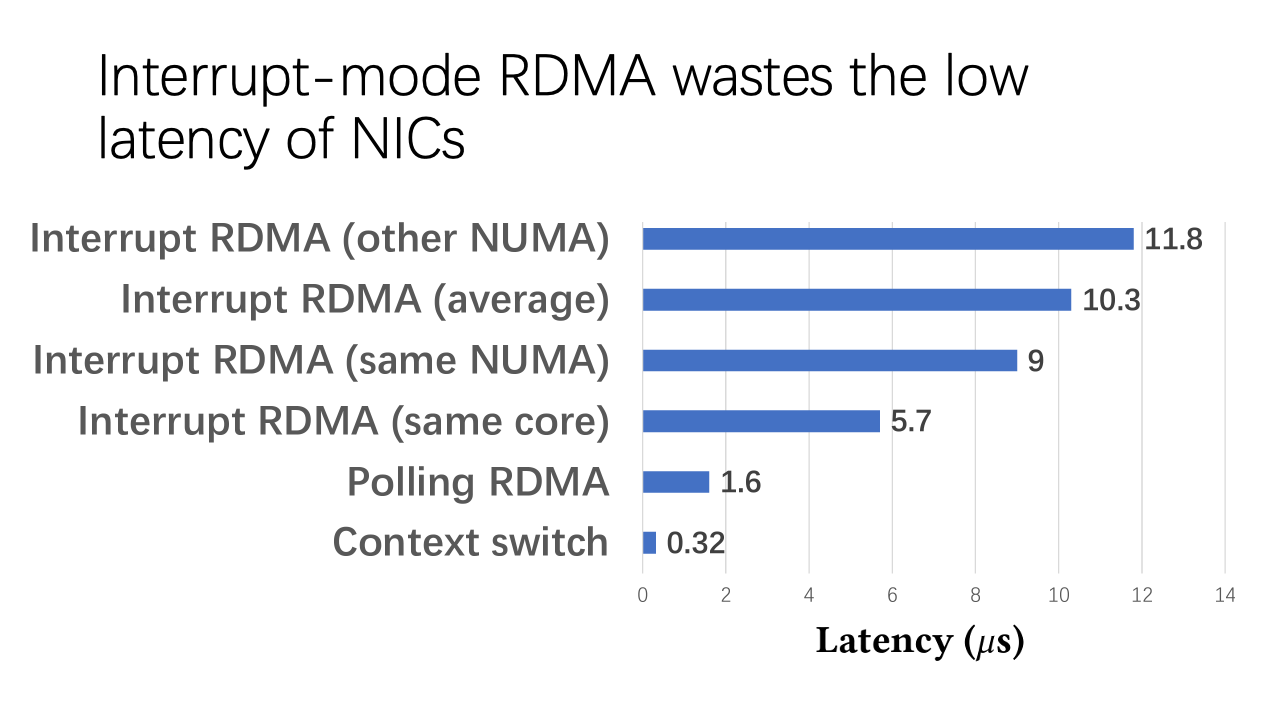
First, let’s revisit why the interrupt mode is crucial for RDMA. There are two scenarios. In some databases, hundreds of threads compete for CPU cores. They require efficient context switching. In other cases, some applications demand low CPU utilization and don’t want to rely on polling, which would make the CPU run at 100% utilization. However, even with RDMA’s low latency, we see that polling RDMA has only 1.6 microseconds of latency, whereas interrupt mode has 10 microseconds. This has led to the emergence of microsecond events which are challenging to address in current operating systems.
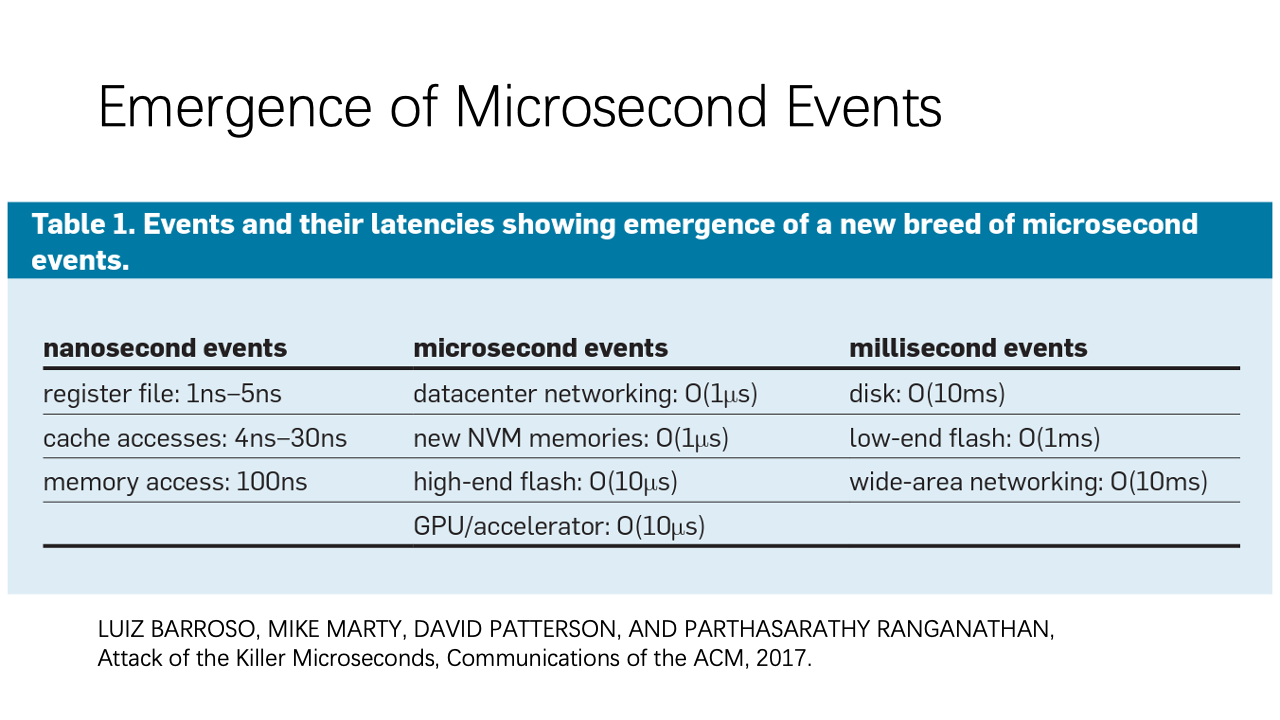
There’s a notable paper called “Attack of the Killer Microseconds” from Google, which highlights that current systems can handle nanosecond and millisecond events but struggle with microsecond events. The reasons are twofold:
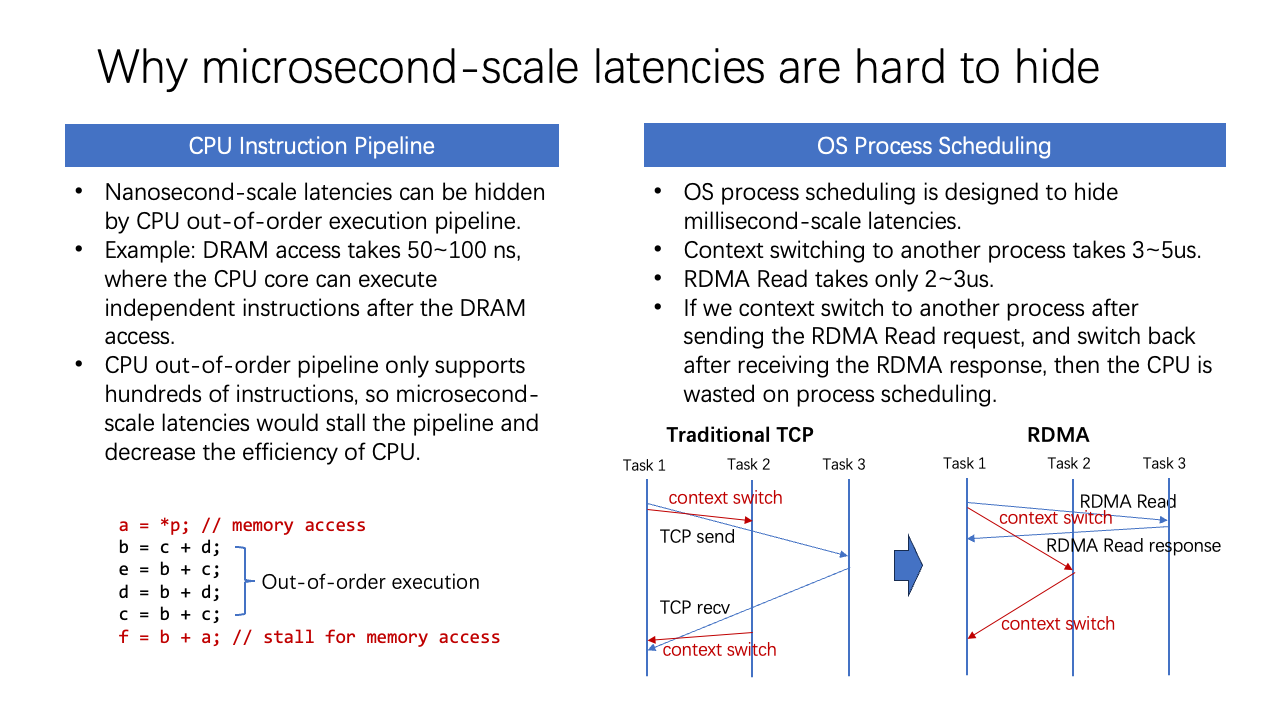
First, the CPU instruction pipeline is designed to mitigate nanosecond-scale latencies due to its out-of-order execution pipeline. But, it can only handle hundreds of instructions, meaning microsecond-scale latencies still stall the CPU pipeline, reducing efficiency.
Second, we can use the OS’s process scheduling. For instance, in traditional TCP, a context switch occurs to another task when the TCP packet is sent out. When the CPU receives the TCP packet, it switches back to the original task. This works well for millisecond-scale latencies. However, if an I/O operation only takes two microseconds, but switching to another process takes three to five microseconds, then valuable CPU time is wasted on process scheduling.
This presents a significant challenge. Our team has proposed a potential approach to address this.
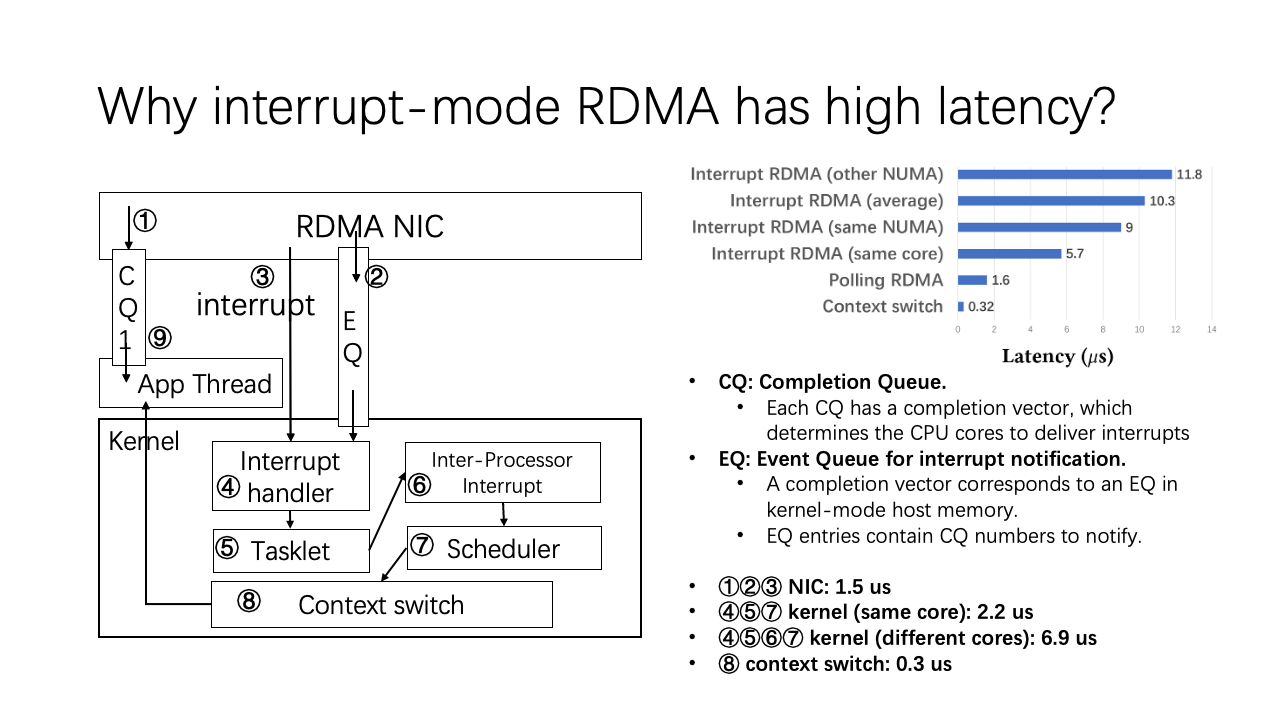
To understand why interrupt mode RDMA has such high latency, we examined the procedure of immediate interrupt delivery. The process involves introducing a completion queue, generating a CQE into the CQ, and for each interrupt notification, there’s an event queue. This event gets generated into the ADMA event queue, subsequently producing an interrupt to the CPU cores. The interrupt handler and associated tasks will then be managed.
The first three steps involving the NIC consume approximately 1.5 microseconds. Depending on whether or not the interrupt core and the thread are on the same core or different ones, the kernel’s subsequent steps take between two to seven microseconds. However, the direct context switch is rapid, consuming only 0.3 microseconds.
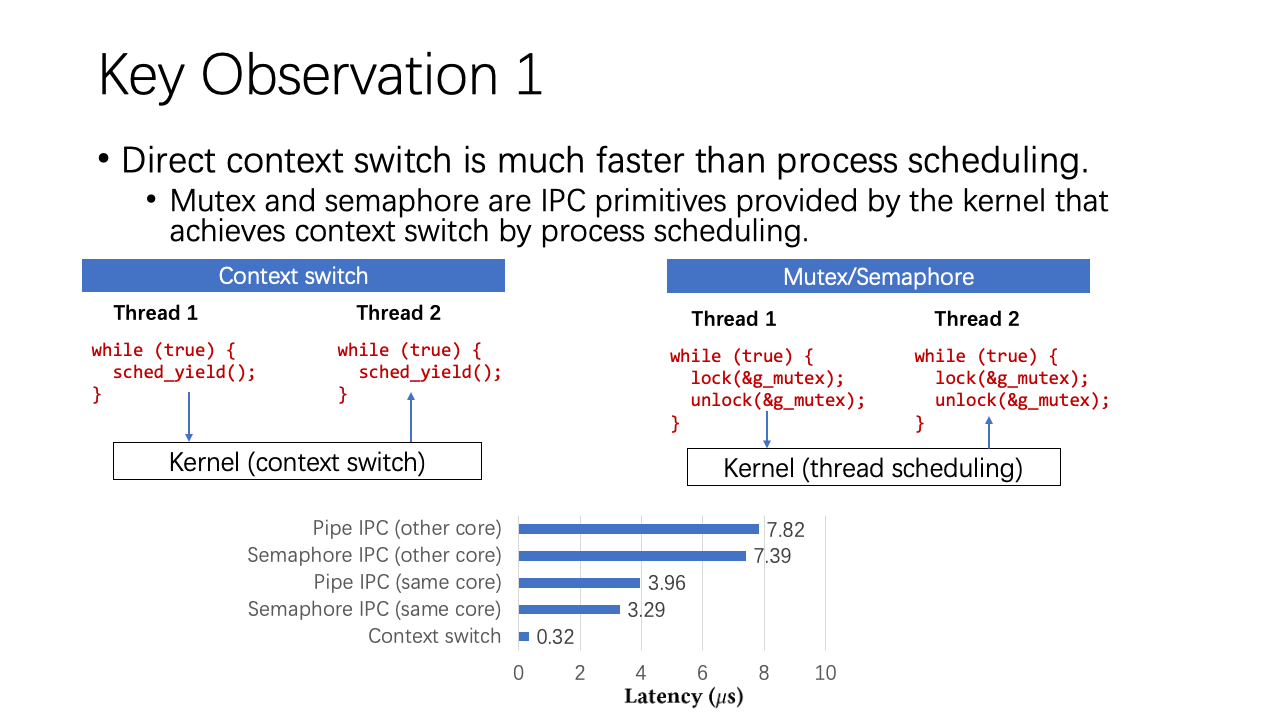
This observation led us to consider if we can mitigate some of these latencies either from the NIC side or the kernel side. Two key observations guide our approaches:
First, Direct context switch is faster than process scheduling. For a direct context switch, let’s consider the left side of this slide. The “yield” function is a system call in Linux that relinquishes the current thread’s execution and places it at the end of the scheduling queue. Consequently, Thread Two begins its execution. Using this method, the context switch only takes 0.3 microseconds. However, if we utilize a mutex or similar IPC primitives provided by the kernel for the context switch through process scheduling, it consumes significantly more time.
Given this insight, our goal is to bypass process scheduling and implement direct context switches instead. This approach promises to streamline operations, optimize CPU efficiency, and pave the way for a more responsive RDMA within data center networks.
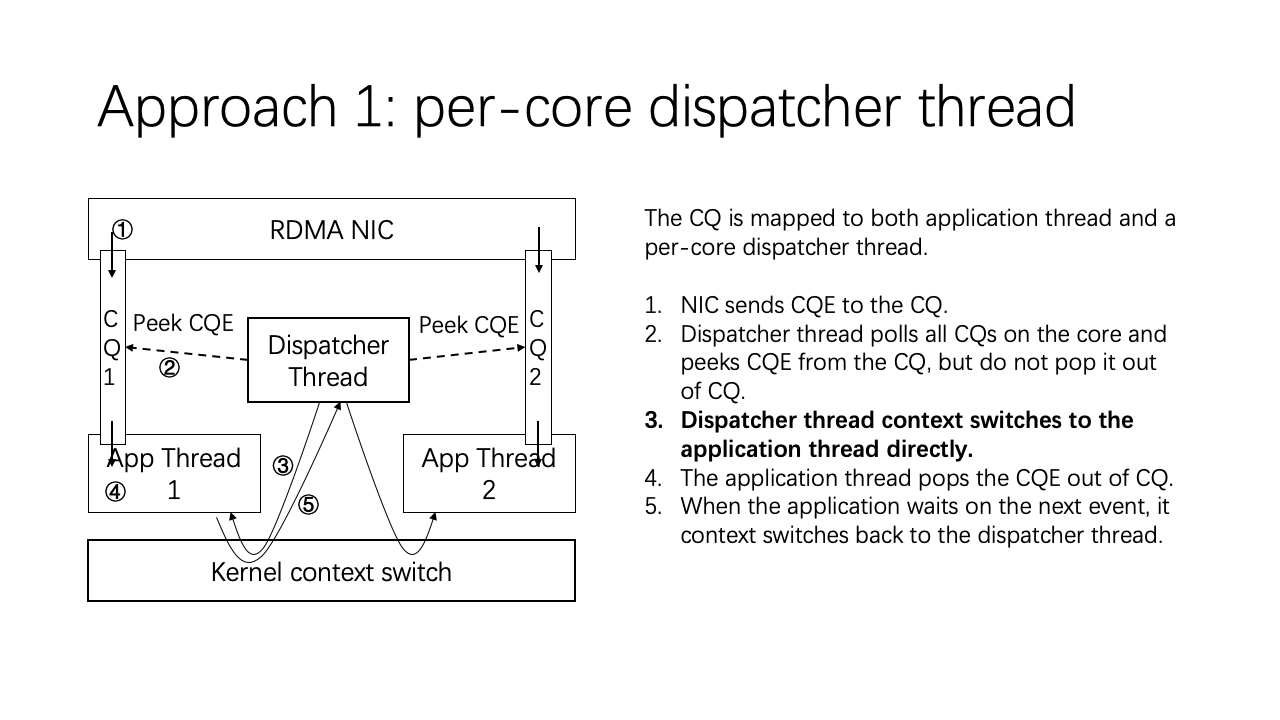
To this end, we designed a dispatcher thread that is mapped to both the application thread and the dispatcher thread. This thread functions as a polling thread. Consider that each CPU core has one dispatcher thread, which manages all the CQs on that core. For instance, whenever a CQ is generated by the NIC, the dispatcher thread first polls all the CQs and identifies the CQE. It identifies but doesn’t extract it. The dispatcher thread then recognizes that this CQ requires action, performing a direct kernel context switch to the application thread. Once the application thread addresses the CQ, it switches back to the dispatcher thread. For other threads, the process is similar.
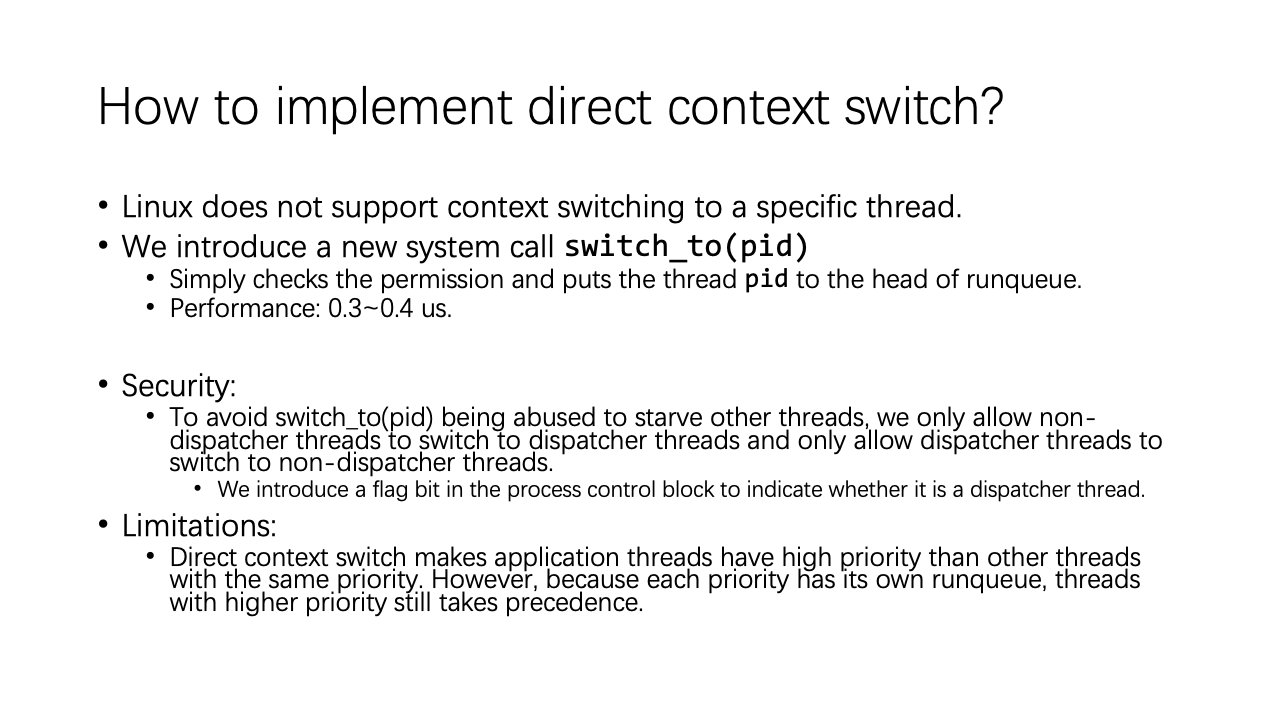
A significant challenge is implementing this direct context switch because Linux does not natively support context switching to a specific thread. We introduced a new system call named “switch_to“ with a single parameter – the PID (Process Identifier).
The “switch_to“ call checks permissions and places the specified PID at the forefront of the runqueue, which manages the scheduling for the current priority. The performance of this system call outshines other IPC semantics.
For security, we aimed to prevent potential misuse of the “switch_to“ call to stifle other threads. We permit only non-dispatcher threads to switch to dispatcher threads and vice versa. A flag bit in the process control block within the kernel was introduced to enforce this rule.
However, there are limitations. Direct context switches can cause the application thread to have a higher priority than other threads with equivalent priority. Hence, there are certain constraints regarding priority inversion.
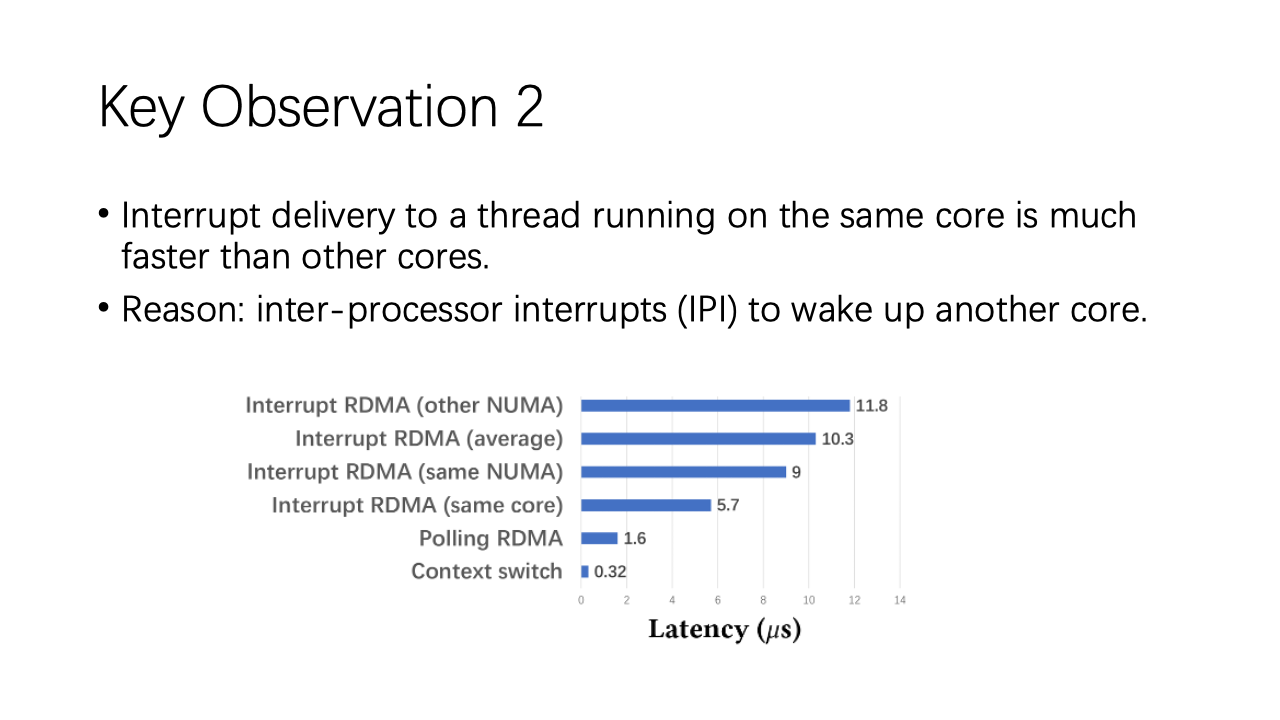
Our second key observation aims to expedite interrupt delivery. One reason our first approach isn’t optimal is that it necessitates a constantly polling CPU core – the dispatcher thread – meaning all CPUs operate at 100% utilization. In our second approach, we aim to cut down on CPU utilization and directly address swift interrupt delivery.
We observed that delivering interrupts to a thread operating on a different CPU core is significantly slower than delivering an interrupt on the same core. Consequently, we proposed an approach focusing on interrupt core affinity. We also sought to shorten the kernel path for greater efficiency.
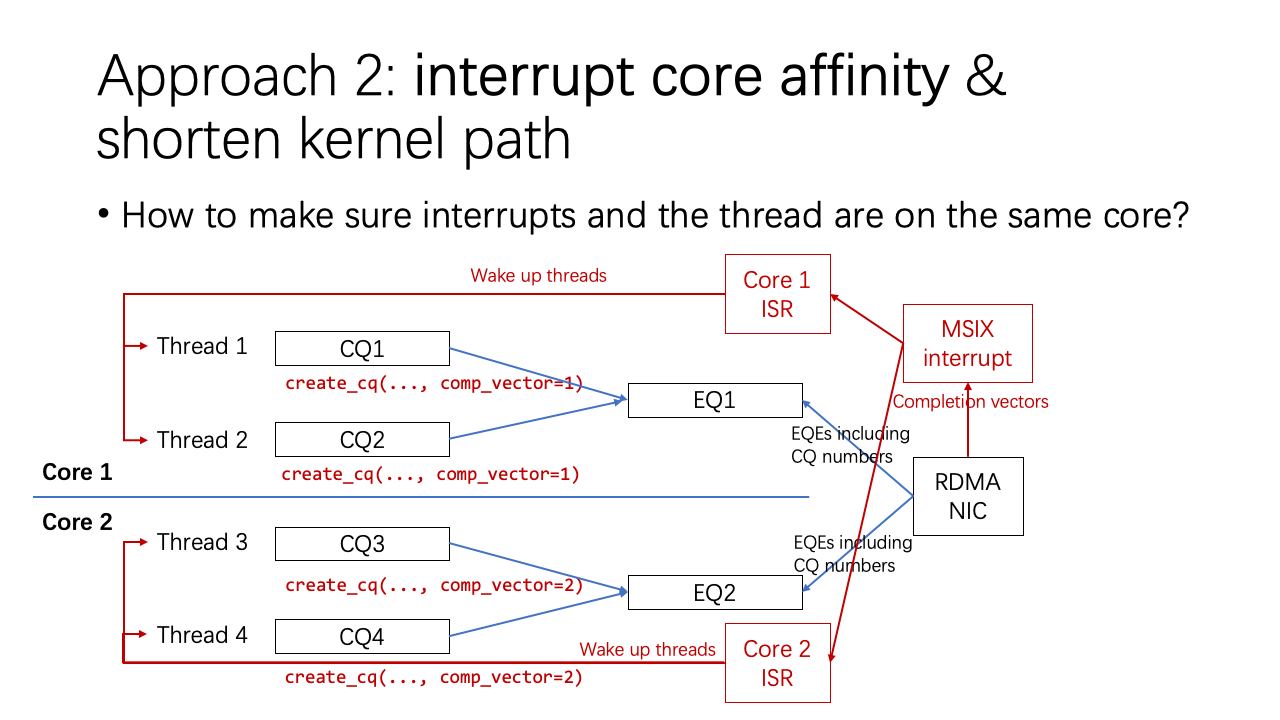
To improve interrupt core affinity, we focused on ensuring that interrupts and threads operated on the same core. This involved the “completion vector” when creating a completion queue in RDMA. This completion vector correlates with an event queue inside the NIC, which is where the NIC delivers its interrupts. The NIC sends interrupts where the event queue lists CQ numbers. If we ensure that the thread and core, as well as the CQ creation thread and user thread, are on the same core, we guarantee optimal interrupt core affinity.
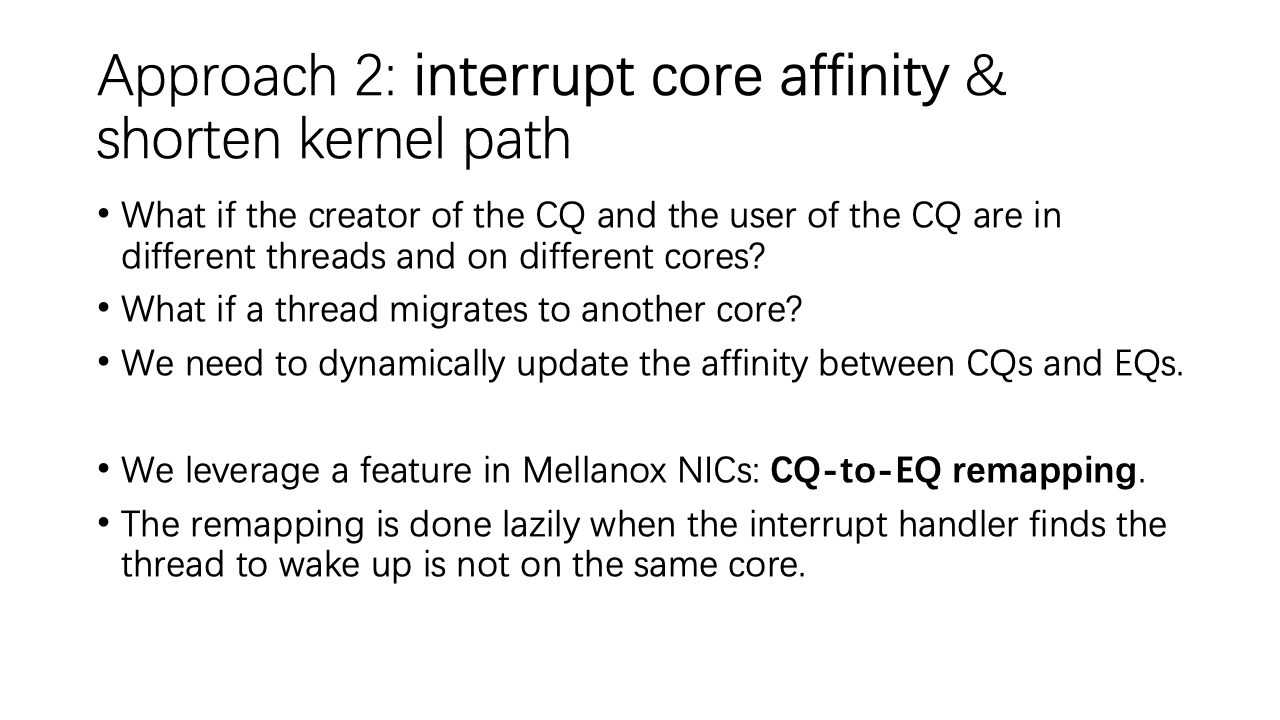
However, there are challenges. For instance, if the CQ’s creator and user operate on different threads, or if a thread migrates to another core during operation, we must dynamically update the affinity between the completion queues and event queues. We utilize a feature in the kernel that allows remapping of the completion queue to event queues. This remapping occurs when the interrupt handler detects that the thread is no longer on the same core as the interrupt handler.
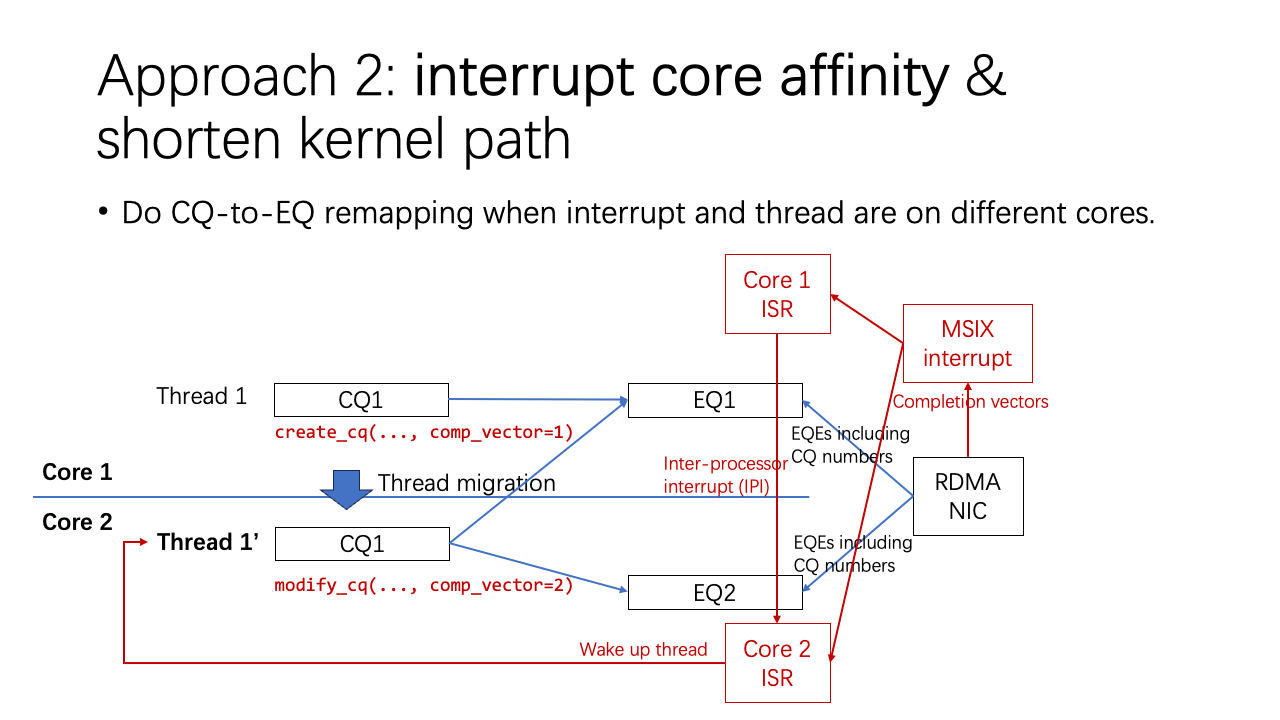
For instance, if Thread 1 migrates from Core 1 to Core 2, the interrupt service routine (ISR) might need an inter-processor interrupt, which is relatively slow due to inter-core communication. To optimize future interrupts, we added a “modify CQ“ call to the OFED (OpenFabrics Enterprise Distribution). This call changes the completion vector, directing the NIC to deliver to a different event queue. This ensures that subsequent operations and interrupts maintain strong core affinity.
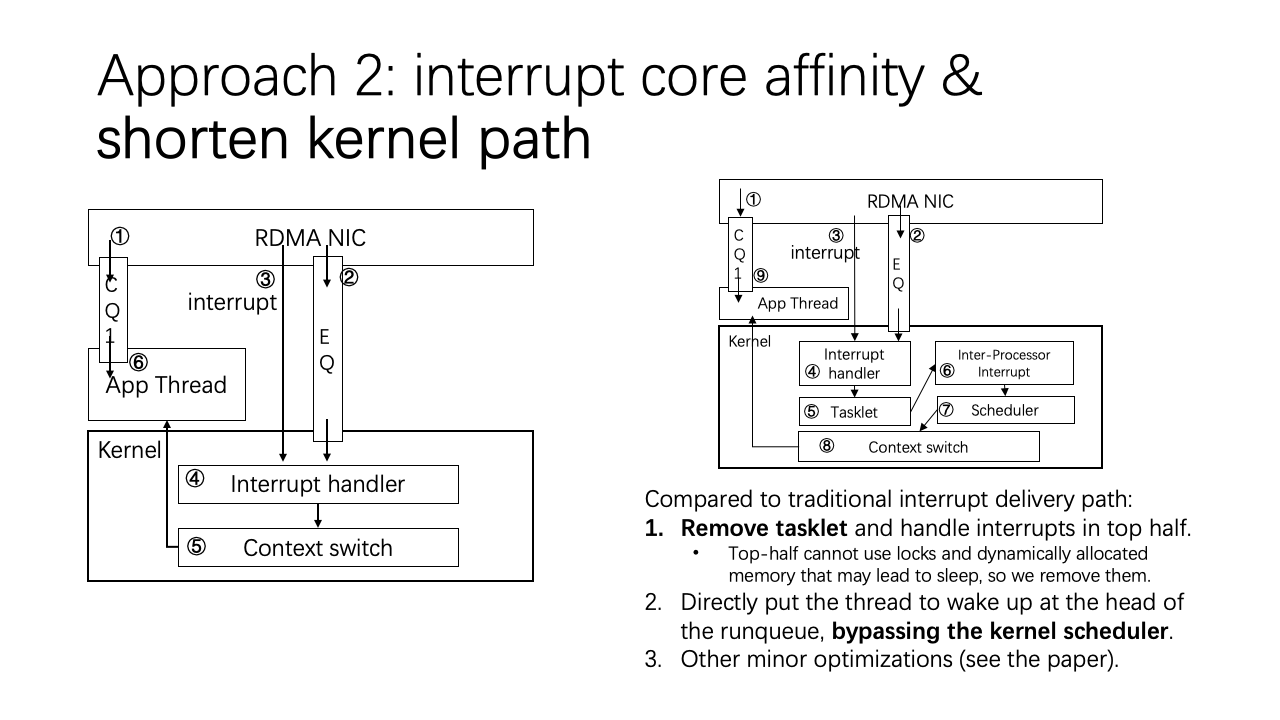
Finally, in our second approach, we also aimed to streamline the kernel path. Upon examination, the original kernel path was intricate and involved multiple steps. We modified this by removing the tasklet and bypassing the core scheduler, along with introducing various other optimizations. This refactoring provides a more efficient and swift path for RDMA operations in data center networks.
First, we handle the CQ, then the EQ, and finally the interrupt. We didn’t make any modifications to these three steps because they originate from the NIC hardware, and we can’t modify that. What we did modify is in the kernel part. In the interrupt handler, we omit the task click and directly handle the interrupt in the top half. Due to some programming limitations in the top half, we had to eliminate some of the locks and dynamically allocated memory. We then perform a direct switch to the thread, bypassing the core scheduler. This makes kernel scheduling very fast.
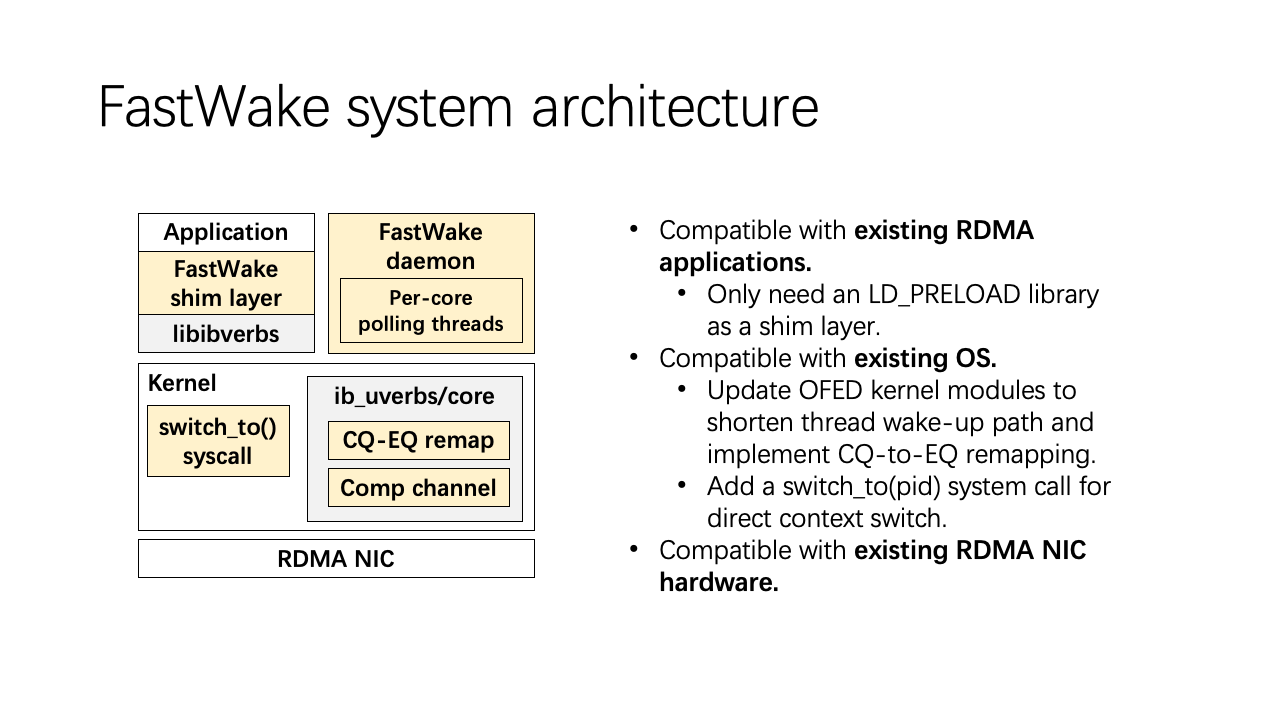
The FastWake system architecture is compatible with existing RDMA applications, operating systems, and hardware. We added the ODPI preload library as a shim layer in the user space. We updated the OFED kernel modules to shorten the kernel path and added a “switch_to“ system call to implement the direct context switch.
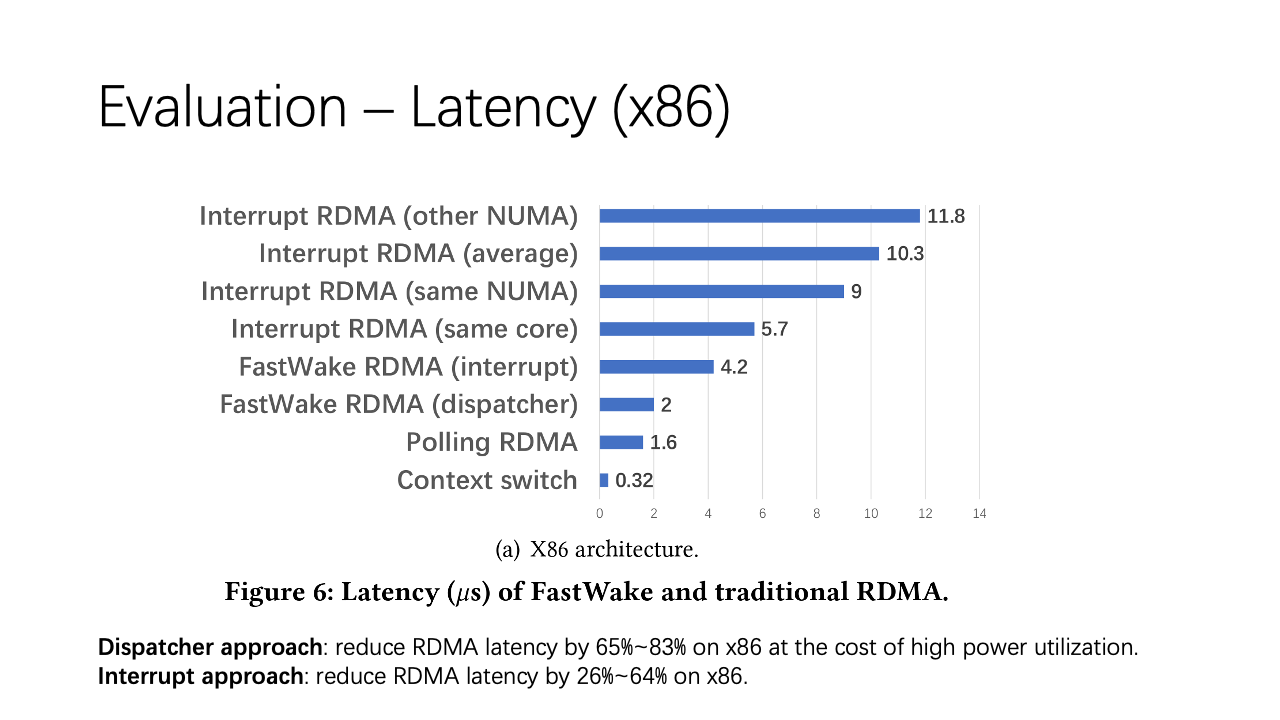
For evaluation, we tested FastWake on both x86 and ARM platforms. With the dispatcher approach, FastWake RDMA adds only about 0.4 microseconds to the ping time. This slight delay is due to the context switch from the dispatcher thread to the user thread. For the interrupt mode, it is slightly slower than the dispatcher mode but still faster than traditional interrupt mode RDMA. This improvement is because we’ve shortened the kernel path and ensured good interrupt core affinity, ensuring interrupts typically run on the same core.
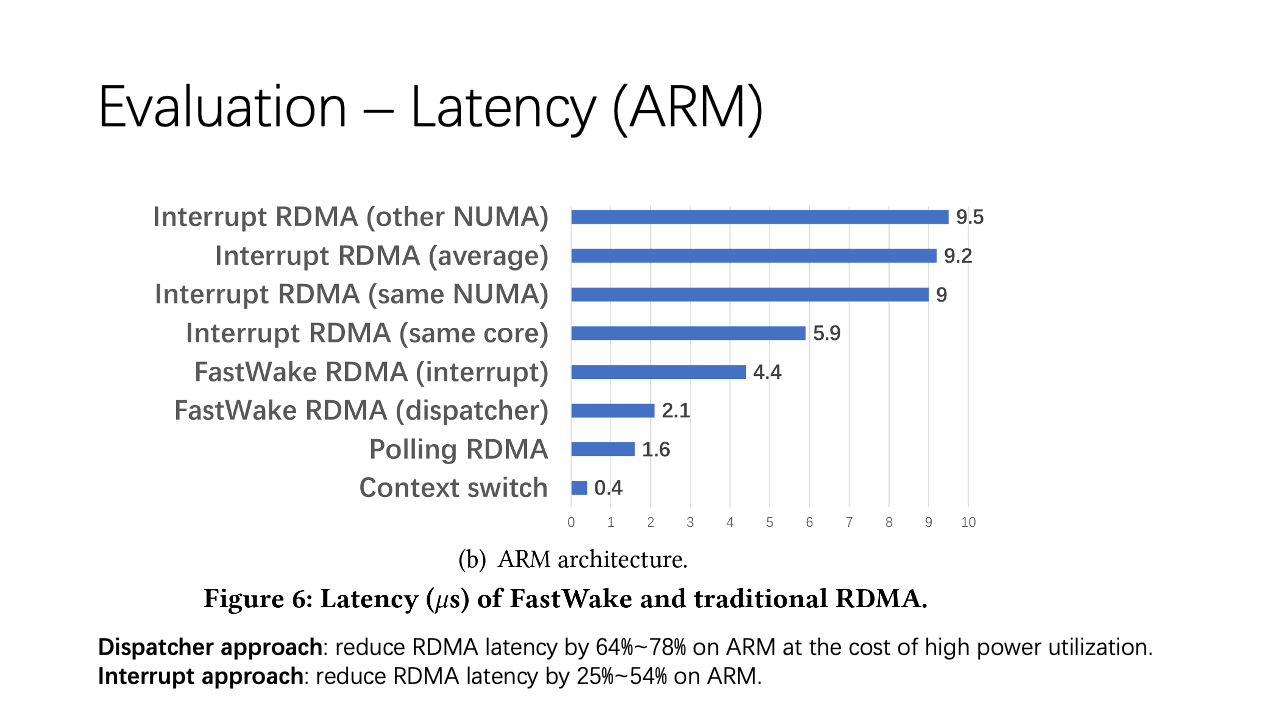
For ARM, results were similar. The FastWake dispatcher is close to the polling case, while the interrupt mode is slower due to the NIC interrupt delivery. However, it’s still much faster than average interrupt RDMA.
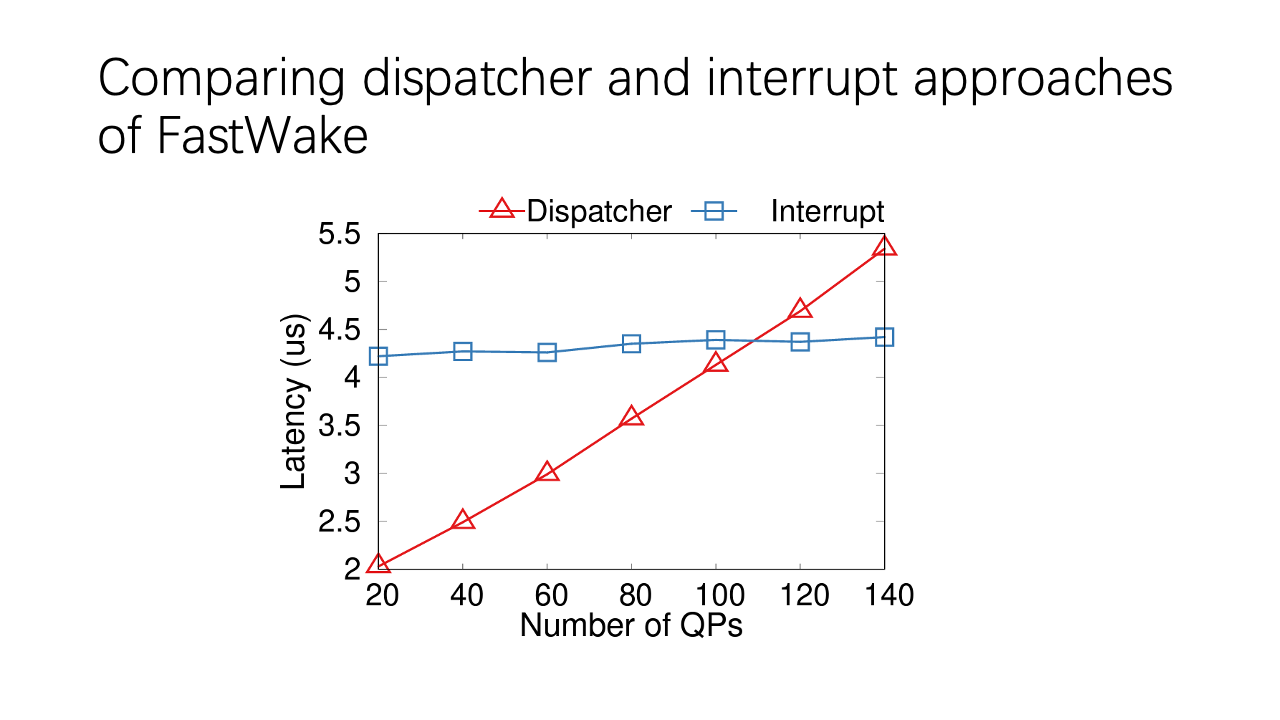
Comparing the dispatcher and interrupt approaches of FastWake: the dispatcher thread polls all the CQs, while interrupt mode doesn’t. So, as the number of QPs increases, latency in the dispatcher thread will increase linearly.
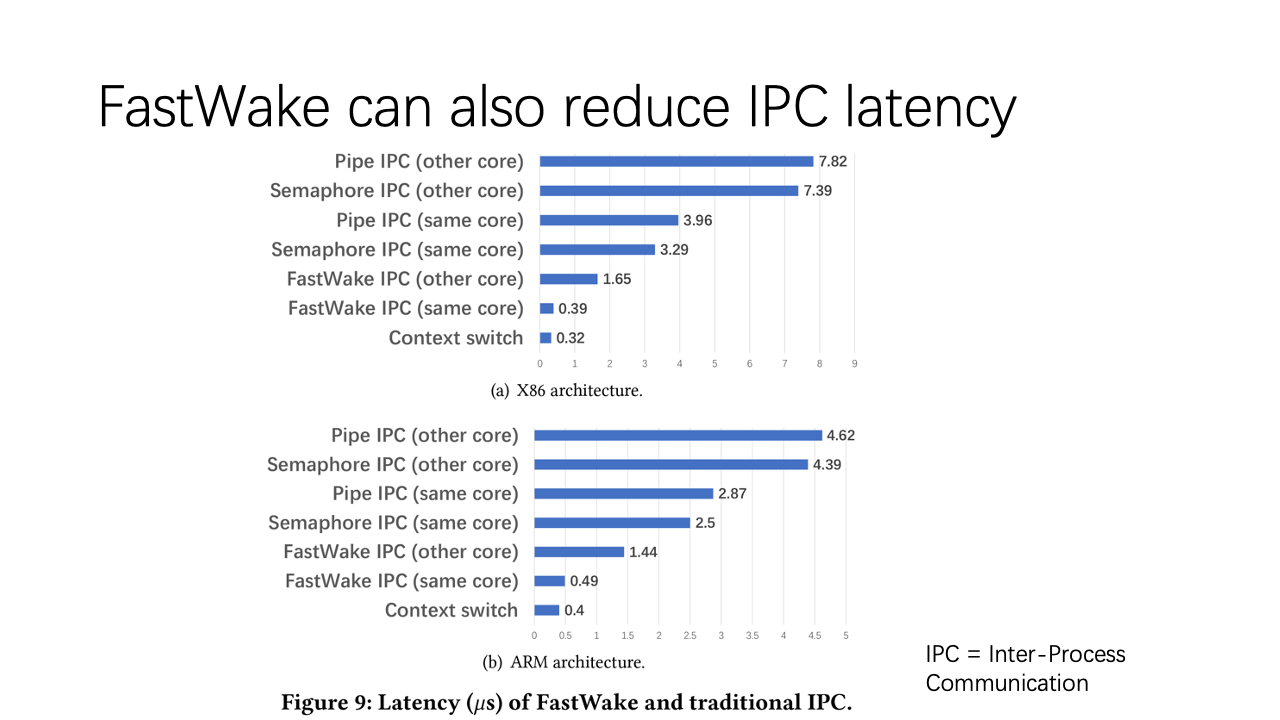
As a side product, FastWake also reduces interprocess communication latency because of the fast context switch. In some cases, it could replace semaphores and mutexes, indicating potential areas for future work.
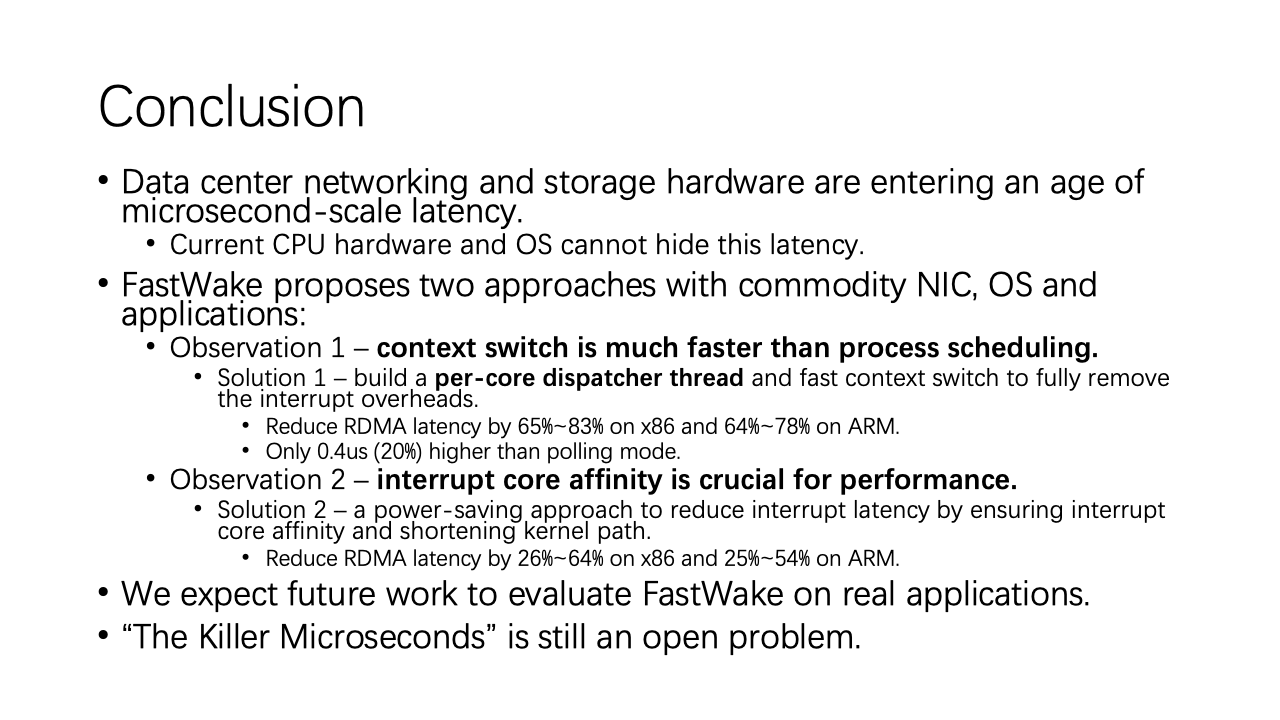
In conclusion, as data center networking and storage hardware are moving into microsecond-scale latency, we face the “killer microsecond” problem. FastWake offers two solutions with community NIC and OS applications based on two observations: context switches are faster than process scheduling, and interrupt core affinity is crucial for latency of interrupt delivery. This work is preliminary, and we look forward to more research on the “killer microsecond” problem. We aim to push performance to the limits of underlying hardware.
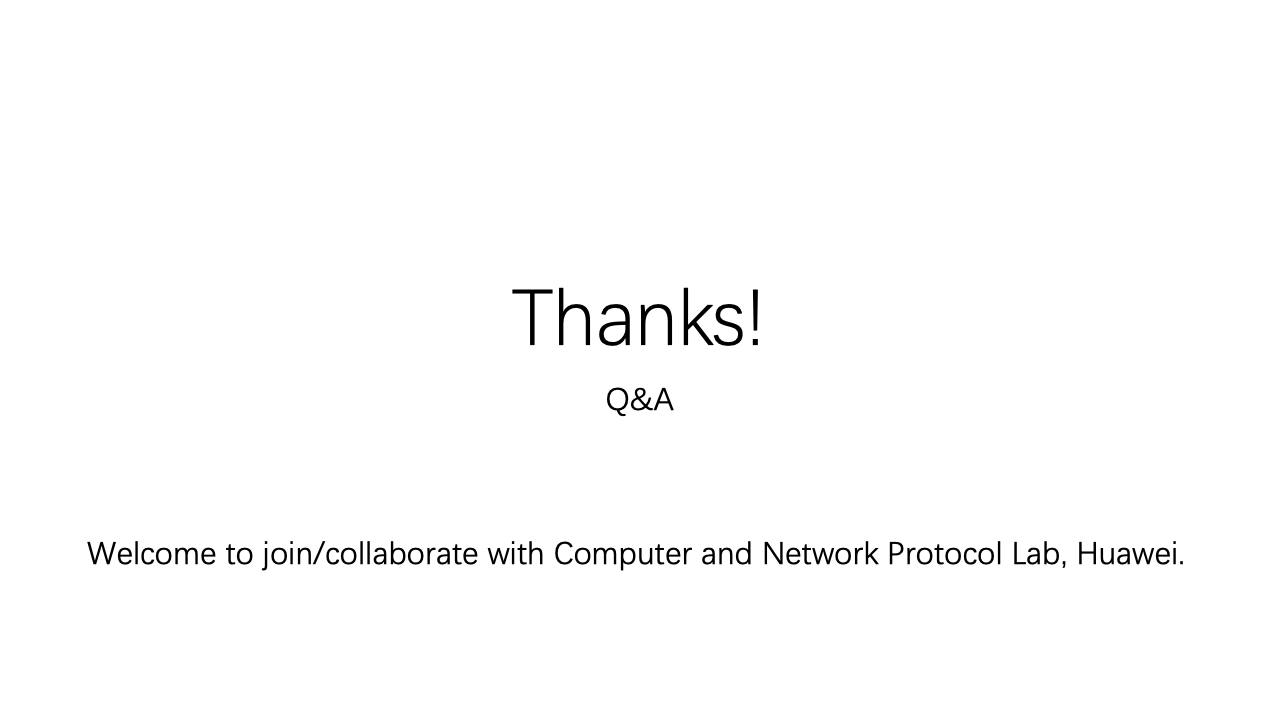
Welcome to join or collaborate with our computer networking protocol lab. It is a fantastic lab in Huawei.
Now, we have time for questions.
Question 1: “Regarding the ‘switch_to‘ interface you introduced: it seems to potentially interfere with existing process scheduling algorithms. Have you considered other methods, like merely boosting the priority of the target thread?”
Answer 1: “Excellent question. We place the target thread at the top of the current priority queue, essentially elevating its priority between its existing level and the next higher one. If another thread has a higher priority, it would still take precedence. Boosting the priority would achieve a similar outcome.”
Question 2: “FastWake comprises two methods. Is it possible that not all applications will exclusively benefit from one approach over the other? Can there be a dynamic switch between the two based on the workload’s demands on the RDMA subsystem?”
Answer 2: “A pertinent observation. The two strategies serve different scenarios. The first, utilizing a polling dispatcher thread, is geared towards situations demanding 100% CPU utilization. The second, focusing on efficient kernel paths and interrupt core affinity, caters to low CPU utilization environments. While it’s conceivable to have a system profiler and optimization function in future iterations to address the exact concern you raised, it’s something we’ve yet to fully explore.”